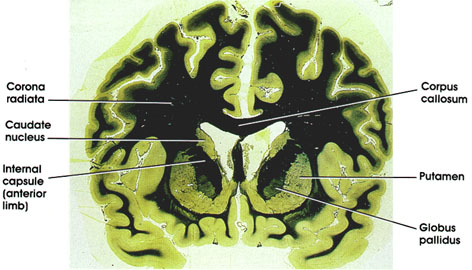

Plate 17.346 Basal Ganglia
Ronald A. Bergman, Ph.D., Adel K. Afifi, M.D., Paul M. Heidger,
Jr., Ph.D.
Peer Review Status: Externally Peer Reviewed

Human, 10% formalin, Weigert's hematoxylin (Loyez), 1.0 x.
Corpus callosum: A massive myelinated fiber bundle connecting the two hemispheres. Important in interhemispheric transfer of information.
Putamen: Located lateral to the anterior limb of the internal capsule. Part of the basal ganglia (along with the caudate nucleus and globus pallidus). Concerned with regulation of movement.
Globus pallidus: Belongs to the basal ganglia (along with caudate nucleus and putamen). Located medial to putamen, and traversed by heavily myelinated fiber bundles. Constitutes the principal efferent nucleus of the basal ganglia. Receives fibers from the caudate, putamen, and subthalamic nuclei and projects fibers to the thalamus (ventral anterior nucleus) and to the subthalamic nucleus.
Corona radiata: White matter core of the cerebral hemispheres. Contains afferent and efferent fibers to and from the cerebral cortex.
Caudate nucleus: C-shaped mass of gray matter closely related to the lateral ventricle. Component of the basal ganglia. Plays a role in motor control.
Internal capsule (anterior limb): Separates the caudate nucleus and putamen. Carries fibers from and to the cerebral cortex.
Next Page | Previous Page | Section Top | Title Page
Please send us comments by filling out our Comment Form.
All contents copyright © 1995-2025 the Author(s) and Michael P. D'Alessandro, M.D. All rights reserved.
"Anatomy Atlases", the Anatomy Atlases logo, and "A digital library of anatomy information" are all Trademarks of Michael P. D'Alessandro, M.D.
Anatomy Atlases is funded in whole by Michael P. D'Alessandro, M.D. Advertising is not accepted.
Your personal information remains confidential and is not sold, leased, or given to any third party be they reliable or not.
The information contained in Anatomy Atlases is not a substitute for the medical care and advice of your physician. There may be variations in treatment that your physician may recommend based on individual facts and circumstances.
URL: http://www.anatomyatlases.org/